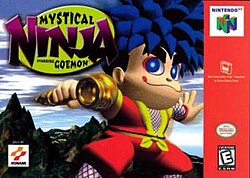Mystical Ninja Starring Goemon
| Mystical Ninja Starring Goemon | |
|---|---|

North American Nintendo 64 cover art
|
|
| Developer(s) | Konami Computer Entertainment Osaka |
| Publisher(s) | Konami |
| Director(s) | Etsunobu Ebisu |
| Producer(s) | Shigeharu Umezaki |
| Designer(s) | Keita Kawaminami Madoka Yamauchi |
| Writer(s) | Keita Kawaminami |
| Composer(s) | Shigeru Araki Yusuke Kato Saiko Miki Yasumasa Kitagawa |
| Series | Ganbare Goemon |
| Platform(s) | Nintendo 64 |
| Release | |
| Genre(s) | Action-adventure |
| Mode(s) | Single-player |
Mystical Ninja Starring Goemon, known as Ganbare Goemon: Neo Momoyama Bakufu no Odori (がんばれゴエモン~ネオ桃山幕府のおどり~?, "Go for it, Goemon: Dance of the Neo Peach Mountain Shogunate") in Japan, is a platform action-adventure video game released by Konami for the Nintendo 64 on August 7, 1997 in Japan and April 16, 1998 in North America as the fifth entry in the Ganbare Goemon series. The second Goemon game released in North America, it follows The Legend of the Mystical Ninja and features hybrid elements of platform games and action-adventure games.
The story follows Goemon's struggles to prevent the Peach Mountain Shoguns gang from turning Japan into a Westernized fine arts theater. The plot calls for three cinematic musical features and battles between giant robots; like other Ganbare Goemon games, it is peppered with surrealist humor and anachronisms.
Mystical Ninja Starring Goemon sold nearly 200,000 copies worldwide. Reviewers praised its graphics, gameplay, and humorous plot. Critics found the soundtrack and tunes memorable and moving, but criticized the localization, unintuitive camera control, and dull stretches of travel through Japan. Goemon's Great Adventure followed in 1999 and Goemon Mononoke Sugoroku in 2000.
Players navigate Goemon through forests, fields, dungeons, and other three-dimensional models of feudal Japanese places. Goemon and his friends can walk or run, jump, attack, and use special abilities to cross terrain, pick up money, and defeat adversaries. Players control only one of four characters at a time but can cycle through them with the press of a button. Hearts at the bottom of the screen show a character's health. If hit by an enemy and damage is taken, a character loses a heart. Some items and acts replenish strength, and a Maneki-neko (Luck Cat) adds a heart to the overall health. If all hearts are lost, the player restarts at the entrance to the field map they died in and the player's number of lives declines by one. If the player loses all lives, the game restarts at the last point saved or at the beginning of the game if a Controller Pak is not used.
...
Wikipedia
